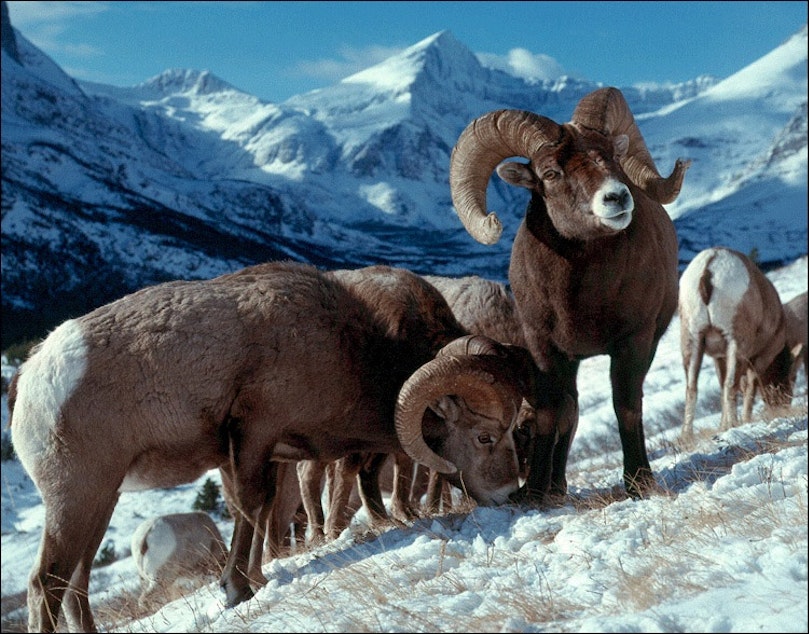Tiny parasite found in bighorn sheep lambs

The steep cliffs and drainages near Hell’s Canyon make for perfect places for bighorn ewes to birth lambs.
To have the lambs, the sheep separate themselves from the herd, partly to avoid predators for the first few days of the lamb’s life, said Katey Huggler, a doctoral student at the University of Idaho.
Huggler would travel daily to monitor these ewes as they gave birth. It’s important to catch and collar the lambs a day or two after they’re born or else the lambs are too fast, she said.
That’s how Huggler started noticing stillborn lambs, two in 2021 and another in 2022, a relatively high number of stillborn lambs for this small bighorn sheep herd.
“It’s kind of a hit when we lose a lamb, especially in such a small population,” Huggler said.
Sponsored
In 2011, the Asotin Creek herd first got hit by a bout of pneumonia, a highly contagious bacteria that can persist in herds for decades, decimating populations. The following die-off cut the herd’s numbers nearly in half. The population has remained stagnant since at about 55 sheep, Huggler said.
“We really want this population to go back to what it used to be, which means we have to have lambs,” Huggler said. “So, it’s kind of a huge bummer when you see that mom had worked so hard to grow this pretty normal sized lamb, and then it ended up just being dead.”
To find out what was happening to the lambs, biologists with Idaho Fish and Game sent the stillborn lambs to Washington State University for analysis.
That’s where researchers at the Washington Animal Disease Diagnostic Laboratory discovered Toxoplasma gondii in the lambs, a parasite more commonly studied in domestic sheep but very rarely found in bighorn herds, said Elis Fisk, an anatomic pathology and doctoral student at WSU.
A study on the parasite and the lamb deaths published Jan. 17 in the Journal of Wildlife Diseases.
Sponsored
Prior to 2019, no one had really reported bighorn lambs with this parasite, said Fisk, lead author of the study.
“So, it was kind of concerning, alarming, really, when we started to detect these deaths and abortions due to Toxoplasma in this relatively short time period,” he said.
To diagnose the parasite, Fisk conducted a necropsy of the lambs. Then, he looked at thin tissues from the lambs, including samples of the brain, heart and lungs. That’s where he found microscopic cysts.
After polymerase chain reaction, or PCR, tests, and in one case additional DNA sequencing, Fisk discovered five of eight lambs had died from toxoplasmosis caused by the parasite.
“In the number of lambs submitted, that’s a pretty big proportion,” Fisk said. “The issue is that eight cadavers, in the grand scheme of things, is still a pretty small sample.”
Sponsored
For one thing, it’s incredibly hard to access bighorn lambs, he said. For another, it’s unknown whether some ewes may have not carried pregnancies to term. In addition, it’s unknown how the bighorn sheep contracted the parasite.
Domestic and wild cats often carry Toxoplasma gondii, he said. Domestic and wild sheep can catch it from the felines.
“If a healthy host is infected with this, they’re not really going to show signs. The real issue occurs in a host that is immunocompromised for any reason or who is pregnant,” Fisk said.
With pregnant animals, the infection can cause the placenta to die or it can infect the fetus, he said.
However, the small study leaves many questions unanswered, Fisk said. Could the parasite stick around in the environment? Is it truly new? Could some lambs live but suffer other problems like blindness, a complication human babies can face from this parasite? Could ewes continue to lose lambs after the first year?
Sponsored
For biologists out in the field, this parasite will mean they’ll have to watch lambs a bit more closely, said Frances Cassirer, a biologist with Idaho Fish and Game.
“We’ve always had some ewes that looked like they were pregnant, and then they would act like they had a lamb, and we never saw them with a lamb,” Cassirer said. “I’ll definitely be thinking more about that and taking more note of that than I have in the past.”
More targeted study and surveillance, especially of herds that live near people, could help answer lingering questions, she said.
“Right now, it’s just one more thing that could contribute to poor recruitment of youngsters,” Cassirer said of trying to re-grow the bighorn population. [Copyright 2023 Northwest News Network]
